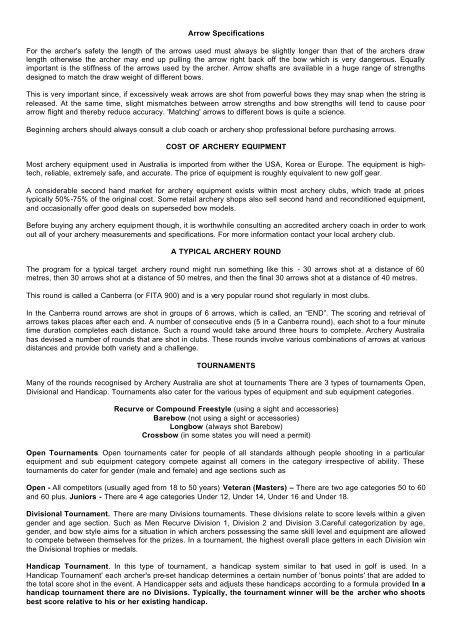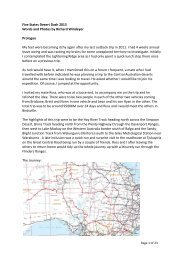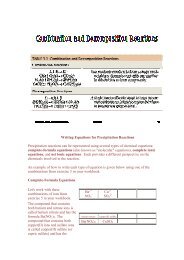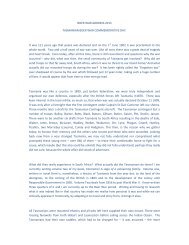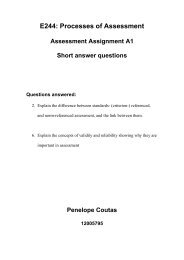Intro to Archery
Intro to Archery
Intro to Archery
You also want an ePaper? Increase the reach of your titles
YUMPU automatically turns print PDFs into web optimized ePapers that Google loves.
Arrow Specifications<br />
For the archer's safety the length of the arrows used must always be slightly longer than that of the archers draw<br />
length otherwise the archer may end up pulling the arrow right back off the bow which is very dangerous. Equally<br />
important is the stiffness of the arrows used by the archer. Arrow shafts are available in a huge range of strengths<br />
designed <strong>to</strong> match the draw weight of different bows.<br />
This is very important since, if excessively weak arrows are shot from powerful bows they may snap when the string is<br />
released. At the same time, slight mismatches between arrow strengths and bow strengths will tend <strong>to</strong> cause poor<br />
arrow flight and thereby reduce accuracy. 'Matching' arrows <strong>to</strong> different bows is quite a science.<br />
Beginning archers should always consult a club coach or archery shop professional before purchasing arrows.<br />
COST OF ARCHERY EQUIPMENT<br />
Most archery equipment used in Australia is imported from wither the USA, Korea or Europe. The equipment is hightech,<br />
reliable, extremely safe, and accurate. The price of equipment is roughly equivalent <strong>to</strong> new golf gear.<br />
A considerable second hand market for archery equipment exists within most archery clubs, which trade at prices<br />
typically 50%-75% of the original cost. Some retail archery shops also sell second hand and reconditioned equipment,<br />
and occasionally offer good deals on superseded bow models.<br />
Before buying any archery equipment though, it is worthwhile consulting an accredited archery coach in order <strong>to</strong> work<br />
out all of your archery measurements and specifications. For more information contact your local archery club.<br />
A TYPICAL ARCHERY ROUND<br />
The program for a typical target archery round might run something like this - 30 arrows shot at a distance of 60<br />
metres, then 30 arrows shot at a distance of 50 metres, and then the final 30 arrows shot at a distance of 40 metres.<br />
This round is called a Canberra (or FITA 900) and is a very popular round shot regularly in most clubs.<br />
In the Canberra round arrows are shot in groups of 6 arrows, which is called, an “END”. The scoring and retrieval of<br />
arrows takes places after each end. A number of consecutive ends (5 in a Canberra round), each shot <strong>to</strong> a four minute<br />
time duration completes each distance. Such a round would take around three hours <strong>to</strong> complete. <strong>Archery</strong> Australia<br />
has devised a number of rounds that are shot in clubs. These rounds involve various combinations of arrows at various<br />
distances and provide both variety and a challenge.<br />
TOURNAMENTS<br />
Many of the rounds recognised by <strong>Archery</strong> Australia are shot at <strong>to</strong>urnaments There are 3 types of <strong>to</strong>urnaments Open,<br />
Divisional and Handicap. Tournaments also cater for the various types of equipment and sub equipment categories.<br />
Recurve or Compound Freestyle (using a sight and accessories)<br />
Barebow (not using a sight or accessories)<br />
Longbow (always shot Barebow)<br />
Crossbow (in some states you will need a permit)<br />
Open Tournaments. Open <strong>to</strong>urnaments cater for people of all standards although people shooting in a particular<br />
equipment and sub equipment category compete against all comers in the category irrespective of ability. These<br />
<strong>to</strong>urnaments do cater for gender (male and female) and age sections such as<br />
Open - All competi<strong>to</strong>rs (usually aged from 18 <strong>to</strong> 50 years) Veteran (Masters) – There are two age categories 50 <strong>to</strong> 60<br />
and 60 plus. Juniors - There are 4 age categories Under 12, Under 14, Under 16 and Under 18.<br />
Divisional Tournament. There are many Divisions <strong>to</strong>urnaments. These divisions relate <strong>to</strong> score levels within a given<br />
gender and age section. Such as Men Recurve Division 1, Division 2 and Division 3.Careful categorization by age,<br />
gender, and bow style aims for a situation in which archers possessing the same skill level and equipment are allowed<br />
<strong>to</strong> compete between themselves for the prizes. In a <strong>to</strong>urnament, the highest overall place getters in each Division win<br />
the Divisional trophies or medals.<br />
Handicap Tournament. In this type of <strong>to</strong>urnament, a handicap system similar <strong>to</strong> that used in golf is used. In a<br />
Handicap Tournament' each archer's pre-set handicap determines a certain number of 'bonus points' that are added <strong>to</strong><br />
the <strong>to</strong>tal score shot in the event. A Handicapper sets and adjusts these handicaps according <strong>to</strong> a formula provided In a<br />
handicap <strong>to</strong>urnament there are no Divisions. Typically, the <strong>to</strong>urnament winner will be the archer who shoots<br />
best score relative <strong>to</strong> his or her existing handicap.


